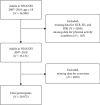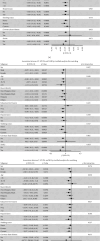Association Between Domain-Specific Physical Activity and Novel Inflammatory Biomarkers Among US Adults: Insights From NHANES 2007-2018
- PMID: 40599559
- PMCID: PMC12213052
- DOI: 10.1155/mi/1989715
Association Between Domain-Specific Physical Activity and Novel Inflammatory Biomarkers Among US Adults: Insights From NHANES 2007-2018
Abstract
Objectives: The novel inflammatory biomarkers, including systemic immune-inflammation index (SII), systemic inflammation response index (SIRI), and neutrophil-to-lymphocyte ratio (NLR), can contribute to predicting the future risk of various diseases. However, the impact of different physical activity (PA) domains on systemic inflammation remains unclear. The study aims to investigate the relationship between domain-specific moderate-to-vigorous-intensity PA (MVPA) and these inflammatory biomarkers among US adults. Methods: Participants from the US National Health and Nutrition Examination Survey (NHANES) (2007-2018) were included in this study. The Global Physical Activity Questionnaire was used to assess self-reported MVPA. MVPA was categorized into three domains, including occupation-related MVPA (O-MVPA), transportation-related MVPA (T-MVPA), and leisure-time-related MVPA (LT-MVPA). SII, SIRI, and NLR were derived from the complete blood count results obtained at the NHANES Mobile Examination Centers (MEC). Weighted multivariable linear regression and propensity score matching (PSM) were used to examine the relationship between domain-specific MVPA and inflammatory biomarkers. Additionally, stratified and mediation analyses were performed to assess potential effect modifications and mediators in this association. Results: The study included a total of 29,072 participants. Following PSM, weighted multivariable linear regression indicated a negative association between LT-MVPA meeting PA guidelines ( ≥ 150 min/week) and circulating inflammatory biomarkers (β = -36, 95% confidence interval [CI]: -47 to -25, p < 0.001 for SII; β = -0.09, 95% CI: -0.13 to -0.05, p < 0.001 for SIRI; β = -0.08, 95% CI: -0.11 to -0.05, p < 0.001 for NLR, respectively), adjusting for all potential covariates in model 2. Participants engaging in sufficient T-MVPA (≥ 150 min/week) also exhibited lower SII and SIRI levels (β = -17, 95% CI: -32 to -2.4, p=0.023; β = -0.07, 95% CI: -0.11 to -0.03, p=0.002). Conversely, O-MVPA showed no significant correlation with any inflammatory biomarkers (all p > 0.05). No significant effect modification was observed in the association between LT-MVPA or T-MVPA and inflammatory biomarkers (SII, SIRI, and NLR). Mediation analysis showed that body mass index (BMI) mediated the relationships between these inflammatory biomarkers and both LT-MVPA and T-MVPA. Conclusions: The impact of different PA domains on systemic inflammation varies significantly. Given the well-established link between chronic inflammation and diseases such as cardiovascular disease (CVD), diabetes, and metabolic disorders, specific recommendations for PA categories should be provided, particularly targeting individuals with high systemic inflammatory responses.
Keywords: NHANES; leisure-time-related physical activity; lymphocytes ratio; physical activity; systemic immune-inflammation index; systemic inflammation response index.
Copyright © 2025 Xin-ying Liu and Kai Yao. Mediators of Inflammation published by John Wiley & Sons Ltd.
Conflict of interest statement
The authors declare no conflicts of interest.
Figures



Similar articles
-
Impact of systemic immune inflammation index and systemic inflammation response index on all-cause and cardiovascular mortality in cardiovascular-kidney-metabolic syndrome.Eur J Med Res. 2025 Jul 21;30(1):645. doi: 10.1186/s40001-025-02929-1. Eur J Med Res. 2025. PMID: 40685352 Free PMC article.
-
Mediating role of inflammatory markers (NLR, PLR, SII, SIRI) in the association between 25(OH)D deficiency and obesity in children and adolescents.J Health Popul Nutr. 2025 Jun 21;44(1):215. doi: 10.1186/s41043-025-00981-5. J Health Popul Nutr. 2025. PMID: 40544313 Free PMC article.
-
Predictive value of systemic inflammatory indices for perinatal outcomes following cervical cerclage: a retrospective cohort study.BMC Pregnancy Childbirth. 2025 Jul 10;25(1):750. doi: 10.1186/s12884-025-07888-3. BMC Pregnancy Childbirth. 2025. PMID: 40640782 Free PMC article.
-
Systemic pharmacological treatments for chronic plaque psoriasis: a network meta-analysis.Cochrane Database Syst Rev. 2021 Apr 19;4(4):CD011535. doi: 10.1002/14651858.CD011535.pub4. Cochrane Database Syst Rev. 2021. Update in: Cochrane Database Syst Rev. 2022 May 23;5:CD011535. doi: 10.1002/14651858.CD011535.pub5. PMID: 33871055 Free PMC article. Updated.
-
Systemic pharmacological treatments for chronic plaque psoriasis: a network meta-analysis.Cochrane Database Syst Rev. 2017 Dec 22;12(12):CD011535. doi: 10.1002/14651858.CD011535.pub2. Cochrane Database Syst Rev. 2017. Update in: Cochrane Database Syst Rev. 2020 Jan 9;1:CD011535. doi: 10.1002/14651858.CD011535.pub3. PMID: 29271481 Free PMC article. Updated.
References
MeSH terms
Substances
LinkOut - more resources
Full Text Sources
Medical
Miscellaneous

